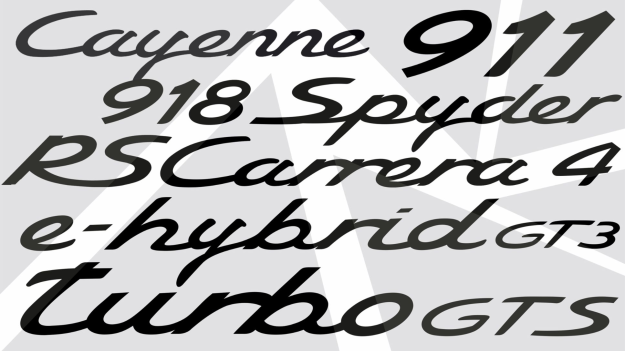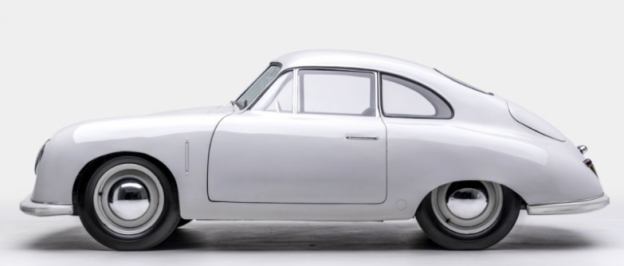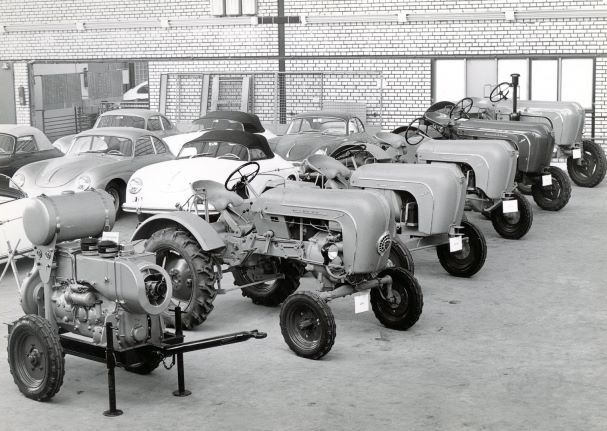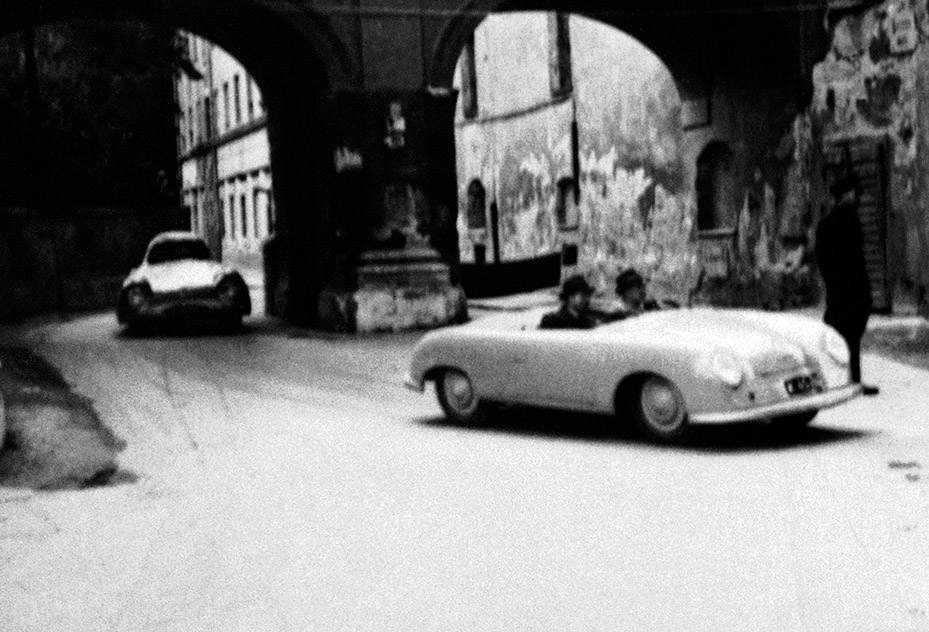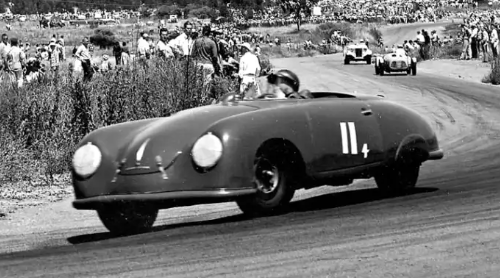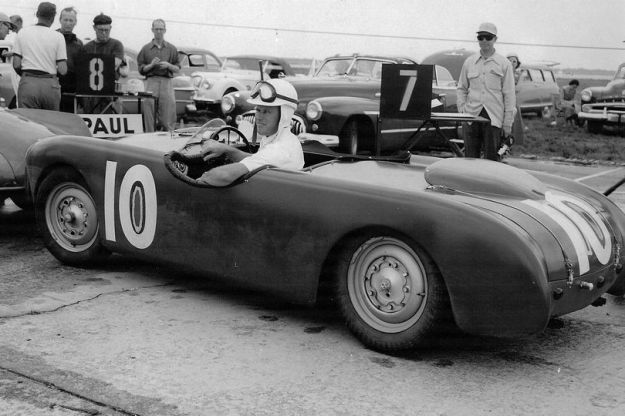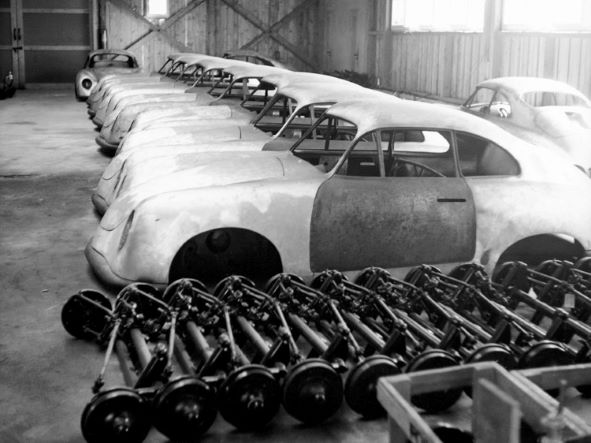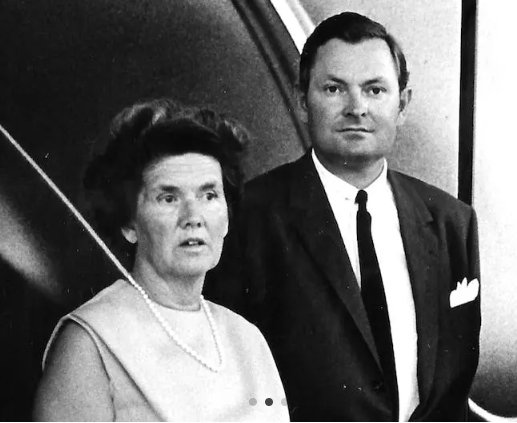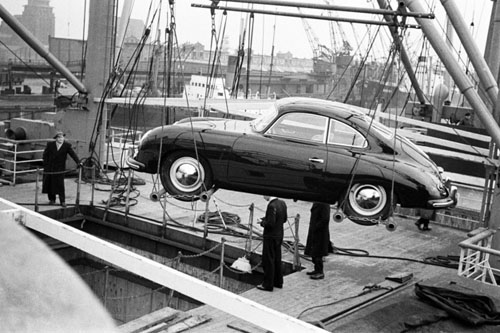18 October 2023
So, this is the fifth ‘spin-off’ from my Savoy Exhibit Archival Blog entries where, in addition to providing more details on the vehicles in an exhibit, I included A LOT of information pertaining the era or movement associated with the cars or ‘theme’ of the exhibit. And, truth be told, I’m actually more drawn to the history-aspects of the eras and themes that I am of the vehicles with are merely ‘artifacts’ or by-products of the era, movement or more recently, the personalities behind the movement.
This spin-off is from the 75 Years of Porsche, exhibit where I was inspired to look back at the history of auto customization from the early 1900’s to more recent times, as well as the current ‘fabricators and customizer’ movement. This one truly became my magnum opus at well over 50,000 words.

Porsche Cars Heritage Section
I’ve created this introductory entry to the 75 Years of Porsche exhibit as I felt some foundational material was needed to give the “collection” context. Here then, are two era specific Porsche models and the personalities that truly define the beginning of the 75-years of Porsche, the brand, which is only part of the story: more on the complete Porsche history follows the exhibit galleries.
Linked Index of Subjects
- The Early History of Porsche
- Porsche North America & Max Hoffman
- The 11 Generations of Porsche 911’s & Links to Add’l Information
- Porsche’s List of the 60 Entertaining Facts and Milestones
About the Exhibit From the Savoy (Preliminary): In 1948, Porsche launched the first model of the legendary brand. The first models of what was to become the 356 were built in a small sawmill in Gmünd, Austria. The 356 continued production with the last one being delivered in May 1966. The Porsche 911 was introduced to the world in the fall of 1963 at the Frankfurt Motor Show. It went into production starting in 1965 and continues even today. This exhibition celebrates 75 years, showcasing some of the significant and iconic models produced by Porsche.
Note: For those who are interested, Gmünd is pronounced like the series of letters “gmoond” said very quicklyas a single syllable word ending with a hard “d”.
My Exhibit Entry Summary
The history behind Porsche (pronounced ‘Por’-shuh) begins with Dr. Ferdinand Porsche, born in Austria-Hungary in 1875, who went on to become a brilliant engineer and successful auto racer who began designing electric cars before the turn of the century. He was 56-years-old when he co-founded his first engineering & development company in 1931, “Dr. Ing. h. c. F. Porsche GmbH, which evolved into what most now know as the Porsche family of companies.
Although having never completed his formal education, Ferdinand was awarded several honorary doctorates and the title of professor, hence the prefix Dr. or Professor and even the name of his company, where ‘Dr. Ing. h. c.’ is the abbreviation of “Doktor Ingenieur Honoris Causa”. However, the first car to carry the Porsche name was designed by Ferdinand’s son, Ferry Porsche, while Ferdinand Sr. and his brother-in-law, Anton Piëch sat in a French prison for their actions on behalf of Germany during World War II. It was Ferry and his sister, Louise Porsche Piëch, who took charge during the war and moved the company back to Austria, designed the first Porsche 356/1 and led the production of the first 52 Porsche Gmünd Model 356/2 cars in 1948, hence why Porsche is now celebrating it’s 75th year of being an auto maker.
Note: Once again, and for those who are interested, Piëch is pronounced like the series of letters “pee-ish” with two syllables.
Ferry Porsche and his sister Louise Porsche Piëch, with early oversight and advice from their father who passed in January 1951, went on to produce hundreds of different vehicles, from tractors to some of the most technologically-advanced race and non-race vehicles in the world. It is now an integral component of Group-Volkswagen AG comprised of ten brands from five European countries including Volkswagen, Volkswagen Commercial Vehicles, ŠKODA, SEAT, CUPRA, Audi, Lamborghini, Bentley, Porsche and Ducati. However, it’s most enduring legacy remains the iconic Porsche models 356 and 911, represented by 11 of the 13 vehicles in this exhibit. And, over the past sixty-years, the iconic Porsche 356’s follow-on model 911 introduced in 1963 has continually been evolving.
The model 911 “family” has gone through eleven generations and at least 22 different special model sub-categories internal since 1963, and it can at times be a bit confusing since the base model number 911 is often times used interchangeably with more than 18 major model series covering 11 generations, many sub-models, variants and special model designations.
As of 2023, 6 different Porsche models are built in series: the Porsche 911, 718, Cayenne, Panamera, Macan and Taycan. Each model is available in many different versions such as the Turbo, Targa or Carrera. In total, there are 95 different variants. Again, there is a dizzying number of Porsche models, numbers, series and generations, and this page at Porsche.coms’s newsroom site does a nice job of breaking it all down:
The Porsche Code: Every Porsche model has an official name and an in-house type number. Sometimes the two are identical, sometimes not – how can the system be understood?
Porsche Heritage: When & Where it Began

It would be hard to write about an exhibit called “75 Years of Porsche” without highlighting the first pure Porsche Model: the 1948 Gmünd 356/1 prototype and the early Gmünd 356/2s that represent the very first pure Porsche models developed and produced in Gmund, located in the Carinthia region of Austria for public sale 75-years ago.
However, an example of the very-rare Gmünd Model 356/2 is not included in this exhibit so I’ve created this introductory homage entry for the original 1948 Porsche 356 series. Feel free to skip-past it if you know the Porsche history and history of the Gmünd Model 356/2. If not, you’re welcome to read on.
The 1st Porsche, the 1948 Gmünd Model 356 (Not on Exhibit)

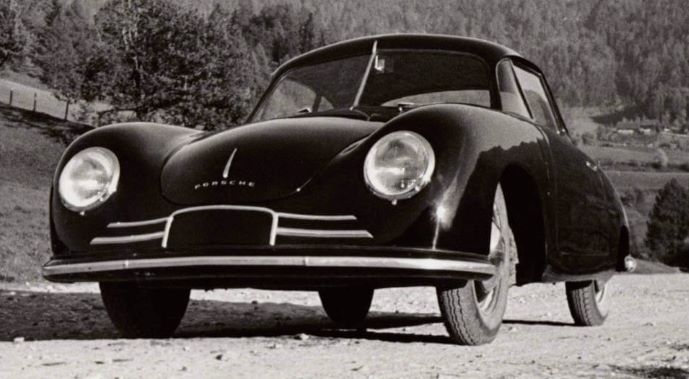


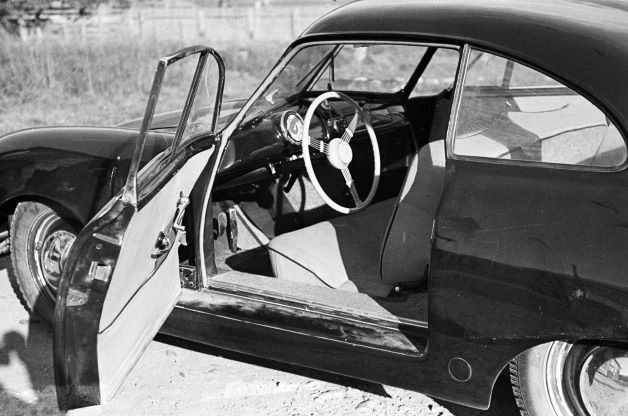
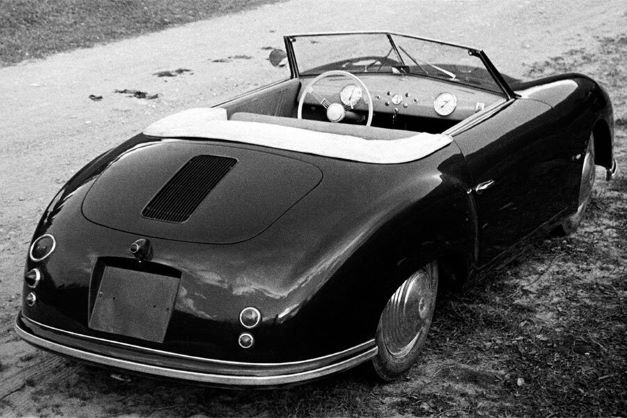
In Brief…
1948 – 1950 Gmünd Model 356: The first models of what was to become the iconic Porsche 356 were designed by Ferry Porsche, styled by Porsche employee Erwin Komenda and built in a small sawmill in Gmünd, Austria. The first Porsche known as the “Sport 356/1” was a roadster shown to German auto dealers, and when pre-orders reached a set threshold, production — with an aluminum body — was begun by Porsche Konstruktionen GesmbH, founded by Ferry Porsche and Louise Porsche Piëch. Many regard the 356 as the first Porsche simply because it was the first model sold by the fledgling company.
On 8 June 1948, the Porsche 356/1 roadster was road-certified and given a general operating license from Austria’s Carinthia state government. The “Gmünd roadster” was powered by a 1.1-liter air-cooled flat-four engine from Volkswagen. The engine’s power was increased to 35 hp for the 356/2. The roadster weighed just 1,290lbs and reached speeds of up to 83 mph. A total of 44 Coupé and 8 Cabriolets were initially produced for sale to consumers.


Jump to: 1957 Porsche 356 Speedster
Detailed History
Sources for this article included: CWI-PCA, Supercars Nostalgia, Stutcars.com and others cited in subsequent articles.
In October 1944 the building that housed the design firm originally co-founded by Ferdinand Porsche in 1931 — Dr. Ing. hc F. Porsche KG in Stuttgart –– became unusable and caused the Reich Minister for Armaments to order them to immediately relocate. Ferry Porsche was initially drawn to Zell am See, where the family owned a property – the Schüttgut. Since space was tight there, the company headquarters were relocated to an old sawmill in Gmünd, Austria. Back then, the town in the Carinthia region surrounded by forests, meadows and fields, was far removed from the turmoil of the world, and could only be reached via a route from Klagenfurt in the south. In November 1944, around half of the Porsche employees were already working in and around the closed sawmill.
After the war in 1946, Ferry Porsche – noting his father Ferdinand was being held in a French prison associated with the war – along with his sister Louise, revived the company. The company kept its head above water with the construction of tractors, mowing fingers and cable winches, and a development contract for the Italian racing car manufacturer Cisitalia provided the financial scope to realize the dream of a Porsche sports car. On June 11, 1947, the first design drawing was created with the project number 356.49.001. At the beginning of 1948, a roadworthy chassis with a tubular space frame was ready, a roadster body designed by Erwin Komenda and made of aluminum was added later.
A few months later, the sports car with the internal type designation “VW-Sport 356/1″ was driving on Carinthian roads – and bore the famous registration number K45 286. As early as July 1948, the newcomer mastered its first test. At the Innsbruck day race, the Porsche 356 “No. 1” Roadster completed a fast demonstration lap, the observers were impressed by the lightweight, which was only 12.5- feet long and weighed less than 1,323 lbs. On July 7, 1948, the “Automobil Revue” wrote the first press report about the “youngest offspring of a big name”. The roadster with a mid-engine – 1.1 liter displacement, 35 hp – heralded the beginning of legendary sports car history.
This introduction was mostly drawn from the Central Wisconsin Region’s PCA Website
Even before the 356/1 design had been completed in June 1948, it became obvious to Ferry Porsche the car’s spaceframe chassis was too labor intensive for volume production. Furthermore, its mid-engine layout was deemed impractical for everyday use.
Porsche therefore set about designing a new car and, in May 1948 just one month before the 356/1 was finished, blueprints for the 356/2 in both Coupé and Cabriolet body styles were completed. Details such as split windows, integrated bumpers, curved quarter windows and two small accent strips between the front indicators were typical of the Gmünd cars.
- Introduction
- Porsche published their first promotional material for the 356/2 in the summer of 1948.
- Rupprecht von Senger and Bernhard Blank then displayed a bare chassis at their Kreuzgarage in Zurich ahead of the first completed car’s debut appearance at the Geneva Motor Show in March 1949.
- Porsche had two vehicles on their stand: a Coupé (chassis 356/2-001) priced at $3,750USD and one of Beutler’s Cabriolets (chassis 356/2-002) priced at $$4,250 USD.
Sales & Delivery: Deliveries of the 356 began in 1949 after the first two cars were shown at the Geneva Auto Show in March. The Motor responded by calling it “One of the smartest little cars of the show” and described it as having “the lowest floor and seating position we have seen in any non racing machine.” With its relatively high cost compared to a VW, the Porsche 356 was selling based on the merits of Ferdinand and the higher costs for British and Italian sports cars.
Most of the first cars were sold in Austria and Switzerland. 15 cars later went to Sweden as part of a deal with Scania-Vabis which took their final car in 1951.
Partnership with Volkswagen & A Return to Germany
In September 1949, Ferry Porsche signed a 20 year agreement with Volkswagen’s General Manager, Heinz Nordhoff, that saw the Porsche company retained for design consultation. In return, Porsche gained access to engineering services and parts supply and their cars could be serviced through the official Volkswagen network. Porsche also took a small royalty payment for every Volkswagen sold.
As for continued production, the old sawmill in Gmünd would never allow sufficient volume for the car building side of the business to become profitable. However, the Porsche family’s Zuffenhausen plant is Stuttgart was still occupied by the Americans, so an alternative solution had found if the company was to return to Germany.
The very reputable Reutter coachbuilding company — based in Zuffenhausen –– and Porsche entered into an agreement in November 1949 whereby Reutter would produce 500 356/2 steel bodies instead of the aluminum used on the Gmünd cars, and Porsche would lease 5,000 sq ft of warehouse space from Reutter where they set-up the final assembly line.
The first Porsche 356 produced in Stuttgart was completed in March 1950, and the last Gmünd 356 was completed in early 1951, noting the last few Coupé were produced by Karosseriefabrik Ferdinand Keibl and Tatra in Vienna who also produced the last two Cabriolets. Porsche’s engineering and administrative staff stayed in Gmünd until December 1950, by which time an additional 1100 sq ft facility had been purchased right next to Reutter.
Postscript on the Gmünd 356/2 Coupé and Cabriolet
The Gmünd Porsche 356/2 cars were produced in almost unbearable conditions in the wooden barracks that made up the plant, nicknamed the ‘Vereinigte Hüttenwerke’ (‘Hut Works Incorporated’).
There was a lack of machines and of materials, and the wooden barracks were bursting at the seams. Space was so tight in the machine barracks that workers could barely squeeze between the lathes. Even outsourcing some of the bodywork and completion processes to small specialist firms such as Beutler, Kastenhofer, Keibl or Tatra only slightly eased matters. On top of this, the transport and customs expenses for the components needed from Volkswagen in Wolfsburg were a hefty financial burden. Ferry Porsche later said of this that ‘there was zero profitability in Gmünd’.
Ferry Porsche later summed up the time in Gmünd with wonder: ‘Today I am amazed that we managed to produce so many cars, given all the problems that there were.’
And, yes… “VW-Sport 356/1″ also known as No. 1, still exists.

Porsche Heritage: Max Hoffman and the Speedster – Porsche Gets American-ized
Similar to the early Gmünd 356/2s backstory, It would also be hard to write about an exhibit called “75 Years of Porsche” without highlighting the importance U.S. auto importer Max Hoffman had in bringing Porsche to America in the way that he did so, perhaps best exemplified by his keen sense of marketing European cars to the U.S. market and consumers with the 1955 Speedster.
Clearly, Porsche would have somehow, someway come to the U.S. Market without Max Hoffman as there were many early entrepreneurs entering the post-war, European sports car market throughout the U.S., such as Hubert Brundage in Florida who went on to become an early Porsche dealer under the made-up name of Brumos, the teletype abbreviation of Brundage Motors, his Volkswagen and other imports business, Johnny von Newmann and his Competition Motors in West Hollywood, California, another early Porsche dealers and many others. However, Max was clearly the right man, in the right place, and at the right time to both introduce the brand in an impactful way and to literally help “shape” the Porsche brand for the U.S. Market.
Getting back to the Speedster, as with the Gmünd Model 356/2, when I saw an early Speedster model would be included in the exhibit, I created a rather extensive entry for the very significant Speedster model developed specifically for the U.S. market . However, it disappeared from the exhibit list so I decided to keep it and move it up into my “Porsche Heritage” section ahead of the the vehicle exhibit galleries and details.
Then, on 28 March another exhibit list appeared and a 1957 356 A Speedster was included. So, I’m keeping this entry here and have creating another one tailored for the 1957 model in the exhibit, that appears further down in the exhibit entry.
1955 Porsche 356 Speedster
Additional Detailed Photos of Interesting Features & Other Info Found in the Internet
In Brief…
1955 Porsche 356 A Speedster: The car was first introduced in 1955, a derivative of the iconic Porsche 356 which was the first production car to bear the Porsche name. The 356 was designed by Dr. Ferdinand Porsche’s son, Ferry Porsche, while the elder Porsche was in a French prison from 1945 to 1947 associated with his work for Germany during World War II. Produced from 1954 through 1959, Porsche sold more than 4,140 Speedsters.
The generally repeated version of the story behind why the 356 Speedster was developed is, American Porsche dealer, Max Hoffman, realized the 356 A would sell better in the States if it could be inexpensive enough to compete with the Triumphs and MGs at the time and Hoffman requested a cheaper model from Porsche. Porsche’s answer was the 356 A Speedster, a model that had only the bare necessities and appeal to buyers in sunny Florida and California where sports car racing was on the rise. The 356 A Speedster became amazingly popular with enthusiasts and racers at the time and earned itself a place in American sports car culture.
Detailed History
Sources for this article included: RM Southebys, Wikipedia, HotCars, StuttCars, ConceptCarz, Sportscar Market, Supercar Nostalgia and Hemmings, MagnetoMag & others
Built from 1948 to 1951, a total of 52 aluminum-bodied Porsche Gmünd 356/2 cars were hand-built in Austria in an old saw mill converted to a temporary, post-World War II home for Porsche’s engineering, development and production operations. By 1950, Porsche had returned to Stuttgart, Germany, where it began production of what became over 76,000 steel-bodied Porsche 356 cars by the end of the model run in 1965.
The steel-bodied 1950 model became the basic 356, but was later referred to by Porsche enthusiasts as the 356 Pre-A. It was following the introduction of the 356 Pre-A in 1950 through 1955, that based on customer feedback channeled through Porsche’s New York-based U.S. Distributor, Max Hoffman, a less expensive, bare-bones open two-seat (OTS) version of the 356 was needed for the U.S. West Coast and Florida markets to compete with the MG, Triumph, Jaguars and other low-cost two-place sports cars.
The first attempt to satisfy this request was a very limited run of sixteen (or perhaps seventeen) aluminum-bodied, very expensive two-place 356 American Roadsters that were produced and delivered to Hoffman and failed to meet the market needs he’d outlined. At the urging of his dealers who had the finger on the pulse of the market, he made a second request for the desired, lightweight, inexpensive roadster to Porsche. The car needed to be price-point designed to meet the needs of both every-day use and, in particular, sports car racing enthusiasts in the now growing Sports Car Club of America (SCCA) events dotting both parts of the county.
Ferry Porsche was not keen on another lightened 356, but Hoffman was, once again outlining a simplified version of the 356 Cabriolet, one without full weather gear, with a lowered, raked, and removable windshield, and with a basic interior with bucket seats. Even a heater and tachometer would be listed as options to keep the car’s price below $3,000.
At first, Ferry Porsche objected to the very concept of building a car down to a certain price, but eventually he agreed. Hoffman and Porsche engineer Albert Prinzing collaborated on what would soon be known as the Speedster, and Ferry Porsche gave the car a green light.
It proved an immediate hit in the western U.S., just as Hoffman had predicted, and it set the tone for lightweight Porsches to come. As many as 4,1441 Speedster 356 Pre-A and 356 A models were produced and sold between 1954 and 1959, nearly all for the U.S. market with just 22 right-hand drive models. A great deal of the Porsches, Speedsters and 550 Spyders imported by Hoffman were allocated to West Coast Porsche dealer, Johnny von Neumann’s dealership in West Hollywood, California.
Note 1: As is the case with so much about rare, collectable cars, the facts and numbers get to be a bit squishy. And, this is the case for the 356 Speedsters. Some sources cite the total number as high as 4,145, which include 1,234 Pre-A’s, with 200 produced in 1954 and presumably 1,034 in 1955. The most consistent number I’ve seen cited is 3,676 and 3,677 but prefaced as being 356 A models. Often times I find sources have intermixed or mis-cited production year counts for model year counts, noting there are many, many overlaps in Porsche model changes. However, the 1,234 Pre-A model number is fairly consistent and a Pre-A 356 is considered one of the most rare, so all that said, I’ve decided to use the StuttCars production number tables, which thus far have more sortable detail than anything else I’ve found, and they cite a total of 4,144.
- 356 A Speedsters – Key Features
- Instantly recognizable by virtue of its low, wraparound windscreen, its smaller and entirely retractable top, lower door waistline and twin bucket seats — all of which emphasize its sporting image — the Speedster ended-up being the ‘economy’ model from Porsche, introduced to compete with the less-expensive British sports cars.
- The Speedster was powered initially by the 1.5-liter version of Porsche’s horizontally opposed flat-four engine, but with the introduction of the 356 A model in 1955, it received the new 1.6-liter, 60 bhp engine at a price of $2,995.
- The Speedster was the lightest of the 356s, enjoying a commensurate performance boost that meant 100mph was possible.
- Combined with its renowned handling characteristics, the Speedster became an instant success in the burgeoning American sports car racing scene.
- Its combination of style, performance and value for money made the Speedster deservedly popular.
- Today the model, arguably the most handsome of the 356 variants, enjoys iconic status.
- Max Hoffman, Porsche’s U.S. Distributor’s Role
- Following the auto galleries on this exhibit page, I’ve included a very detailed article regarding Porsche’s U.S. Distributor, Max Hoffman, his influence and impact on the auto industry and the explosion of European imports to the U.S. after World War II, including those by Porsche; the following is a very brief summation of the story:
- Hoffman immediately demonstrated good instinct for the automotive needs of his customers, and by listening to his dealers and customers, was responsible for the creation of a Porsche legend.
- Based on what he learned based on feedback regarding the 356, Hoffman told Zuffenhausen the American market, sport car enthusiasts and club racers were in need of a light, open and inexpensive sports car, one that is efficient and has the lowest possible air resistance.
- Ferry Porsche acted on Hoffman’s suggestion and the Porsche 356 Speedster was eventually the result.
- The Hoffman Motor Car Company dealerships offered the new sporty and fuel-efficient 356 model for $2,995 USD.
- Right from the start, the model sold well and, as predicted, was used in everyday life as a daily driver, and on the weekend by many buyers at racing events that were taking place all over the country at the time.
The Story Behind the Birth of the Porsche 356 A Speedster
The generally repeated, short version of the story behind why the 356 Speedster was developed goes something like this: American Porsche dealer, Max Hoffman, realized that the 356 A would sell better in the States if it could be inexpensive enough to compete with the Triumphs and Mgs at the time, so he requested a cheaper model from Porsche. Porsche’s answer was the 356 A Speedster – a model that had only the bare necessities. As the story goes, the 356 A Speedster became amazingly popular with enthusiasts and racers at the time and earned itself a place in American sports car culture. Furthermore, it became integrated into Californian culture where its basic configuration and lack of advanced weather equipment was more than appropriate and still is to this day.
The U.S. Market Warms to the 356, But Needs A True Roadster
Porsche’s North American importer, New York-based Max Hoffman and his long-time friend from Vienna, fellow émigré and owner of Competitive Motors in West Hollywood, California, Johnny von Neumann, watched Americans snap up Porsche’s 356 and knew they the small, four-cylinder sport car would resonate even better with sun-loving West Coast buyers if a drop-top roadster was available. Hoffman approached Ferry Porsche with the idea and, by late 1950, with Ferry Porsche’s approval, Porsche’s Heinrich Sauter built a running metal-bodied prototype that would go on to be called the American Roadster.
Hoffman liked the idea but Porsche himself thought it was too heavy to be a viable competitor in the quickly advancing road-racing scene in the U.S. After considering the Sauter design, Porsche specified a more lightweight aluminum body fabricated by Heinrich Closer Karosserie in Wieden-Ullersicht near Nuremberg, which bumped the retail price to $4,600, well-beyond the $3,000 target von Neumann and Hoffman believed was a key feature.
A Swing and a Miss: The American Roadster
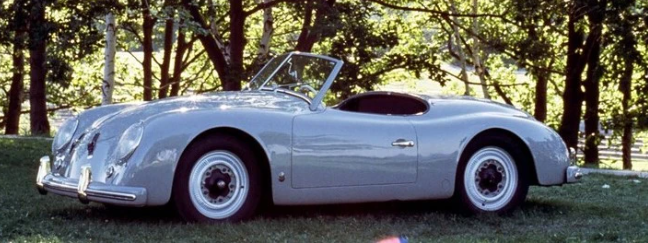
American Roadsters were truly Porsche’s first purpose-built racing cars and racing victories by drivers like Jack McAfee, Ken Miles, and others, reported in American newspapers, did as much for Porsche in the U.S. as racing had done in Europe. However, even though it was a better performance car than its rivals, only 17 of the 1952 aluminum bodied America Roadsters were built. The cars were just too expensive and out of reach for von Neumann’s target customers, noting von Neumann had his finger on the pulse of the market being a man who enjoyed racing more than selling cars, and who was deeply involved in the sports car racing movement in the U.S..
As interest by customers in an affordable, open-seat roadster continued to grow, von Neumann visited Hoffman again to lobby for another open car for the streets retailing for no higher than $3,000 to compete on price and performance with Triumph, Austin-Healey, and Jaguar.
Did a Butchered-Up LeMans-winning Porsche Gmünd 356SL Coupé Get The Message Across?
Without a doubt, the Speedster’s inspiration can be traced back to the Southern California weather and it’s ideals sports car market, racing: Von Neumann wanted a lightweight car to race and wanted a roadster body style because of climate. von Nuemann’s commitment to the concept can be best illustrated with a photo of his chopped – top, former LeMans-winning Porsche Gmünd 356SL Coupé in the early 50’s that he raced to great success.
Explaining such a car’s appeal Neumann once said: ‘Guys want to go, on a Saturday night in June, down Sunset Boulevard with their elbow over the door and the girls can see them in the car. An affordable car that could be used in everyday life as a daily driver and, on the weekend, also entered and raced at SCCA sanctioned events taking place all over the U.S. at the time.
This consumer insight, and the photo of Neumann’s highly-modified Porsche Gmünd 356/S SL, — never mind the same message regarding consumer interest coming from other Porsche/Volkswagen dealers like Hubert Brundage of Brundage Motors, aka, Brumos Porsche in Florida –– likely went a long-way toward convincing Ferry Porsche to give a green-light to the 1955 Porsche 356 Speedster.
After Reutter slightly redesigned the roadster body and stripped every accessory from it, Porsche delivered its new low-slung Speedster in 1955 for $2,995. They sold like mad. And, owners paid extra for everything: tachometers, padded seats, floor mats, sun visors, cigarette lighters, heaters, and even clip-on hardtops.
A docile 1500cc Normal 60 bhp engine was available. So was Ernst Fuhrmann’s new four-cam Carrera-engine GS-GT package with 100 bhp. Not only did the name “Speedster” enter enthusiast jargon, but so did the car’s shape, which resembled an over- turned bathtub.
Produced from 1954 through 1959, Porsche sold more than 4,140 Speedsters.
Who Deserves the Credit?
Although Hoffman, receives credit for coming-up with the Porsche 356 Speedster’s introduction and success in the U.S., the concept and design criteria Hoffman shared with Porsche was a pitch that came from his long-time friend von Neumann.
Personally, after doing my research on this exhibit, I do believe Hoffman does deserve a lot of the credit, since he created the U.S. European import market beginning in 1947, established a large network of dealers, many of whom were of like mind, ambition, also racing cars and had the ear of all the major European automakers who were aggressively looking to expand their export markets to the U.S.. And, Hoffman had already proven he understood American consumers and could “move iron” giving him clout when he needed concessions or had insight into what types of cars would sell well in the U.S..
How Johnny von Neumann came to own the LeMans-winning Gmünd 356/2 SL
In 1950, eleven remaining Gmünd chassis were assembled after Porsche returned to Germany and were converted to SL (Sport Leicht) racing specification. Renumbered as 356/2 3000 series cars, according to a factory workshop memorandum dated 24 March 1951. they received 1,086-cc engines, enlarged fuel tanks, louvered quarter-window covers, wheel spats, streamlined aluminum belly fairings, and a pedestal-mounted shifter: no seatbelts or roll bars were installed in the aluminum bodied cars. A variety of other modifications were made to just the three LeMans cars.
In this amazing, but also credible version of the story, after completing the original production run of Gmünd 356/2s, Porsche kept a supply of aluminum Coupé bodies for their own use as factory competition cars. Known as the Super Liecht (SL) or Sport Light that were much lighter than the now steel-bodies being produced by Reutter coachbuilding in Stuttgart for the 1950-1955 356/2s.
Porsche designated three of these Coupé for their first attempt at LeMans in 1951: chassis no’s 356/2-054, 356/2-055 and 356/2-063. However, #54 and #63 were damaged before the race and a fourth car with chassis no. 356/2-056 was sent to LeMans and renumbered as #63: a common practice at the time.
The two cars that started the race were the newly re-stamped chassis #063, was given the race number 46 while its sister car, chassis #055, received the race number 47. The 46-car / 356/2-063 performed flawlessly, and in their first attempt, Auguste Veuillet and Edmond Mouche crossed the line in 20th place overall, were 1st in the 1,100-cc class. This was also the first victory for a German sports car in international racing after the war.
At the end of the racing season, Porsche shipped three Gmünd 356 SL cars to their American distributor, Max Hoffman. These three cars were the same three that were prepared for and went to the 1951 Le Mans 24-Hour race: chassis #054 and #055, both of which had been repaired, and #063. Hoffman sold these three cars to Fritz Kosler, Ed Trego and John von Neumann.
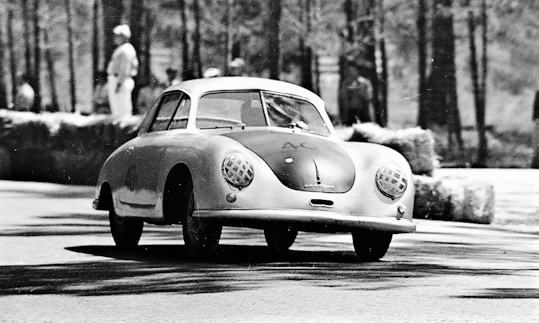

At above left, the Le Mans Porsche 356 SL being raced by John von Neumann, not yet painted red and with the number 11. At above right, now with the distinctive red paint and white number 11 it wore, prior to having the roof removed.
Von Neumann’s West Coast Porsche dealership in Hollywood, Competition Motors, would come to play a significant role in promoting the Porsche brand through his racing exploits. His first race after acquiring the Gmünd 356 SL was at Palm Springs in March 1952, and the following month he raced it at Pebble Beach, but retired with brake woes. By the time of his next race at Golden Gate Park in San Francisco, chassis #063 had been given a make-over in red but he posted another DNF due to brake problems. Von Neumann’s first race win came at Torrey Pines in July 1952, which gave Porsche its first victory on American soil.
In a surprise move, von Neumann commissioned Emil Diedt, a very talented metal worker in Southern California, to remove the Coupé roof to improve the car’s aerodynamics and to reduce weight. This was an age when a race car had a very short serviceable life, and once it had gone beyond its use by date, it was open to almost any kind of butchery or modification. As expected, removing the roof from 356/2-063 turning it into a roadster, reduced the car’s weight by around 110lbs and significantly reducing the frontal area. Von Neumann also removed the front wheel fairings as, despite improving the car’s aerodynamics, they restricted airflow to the front brakes causing them to overheat.
Later that year, von Neumann sold the car to Bill Whittington, who painted it a blue-grey colour. It then passed through several other owners, before Chuck Forge, an electrical engineer and sports car racer, happened upon the unwanted roadster in 1957.

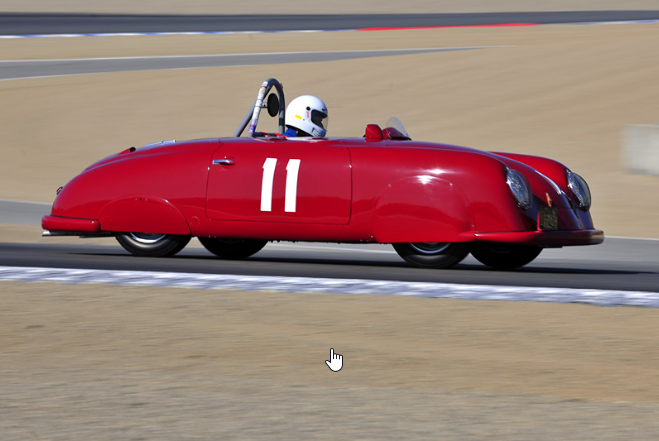
At above left, the former, topless 356/2-063 Von Neumann now owned and being raced by Chuck Forge not too long after he acquired it. Forge would own the car for the next 50-years. At above right, now with the distinctive red paint and white number 11 after being restored and still be driven by Chuck Forge.
Chassis #063 had by now had an extremely hard life, and so Forge removed the Porsche engine which was on its last legs and he installed a new VW engine, using it as his daily runabout. In fact, Chuck Forge lovingly kept and maintained the little Porsche for the next fifty-two years until his passing in 2009. During this time, he restored the car in 1981 and had it finished in the red colour as von Neumann had raced it, and continued to competed in autocross events, rallies, numerous classic car events and the Continental Sports Car Club tour.
Von Neumann’s Subsequent Years & the Porsche Bertone 911 Spyder
Various sources including ConceptCarz and Hemmings
Von Neumann was awarded an official Porsche / Volkswagen dealership in 1953, continued racing, moving on to own and race one of the first Porsche 550 RS Spyders, 550-003. When he began racing Ferrari’s, he offered seats in his Competition Motors racing teams to the likes of Ken Miles, Richie Ginther, Phil Hill and Jack McAfee.
As an interesting aside, when the Porsche 911 and 912 models arrived in 1965 signaling the end of the 356 and its Cabriolet and Speedster versions, Von Neumann once again began to pitch the need for a 911 roadster. However, Porsche had already developed a 911 cabriolet prototype, tested it and realized the 911 without it’s roof structure induced excess chassis flex for a sports car and there was not enough room for a folded top, unless it rested atop the body over the engine like the VW Beetle cabriolet, both of which were unacceptable to Ferry. Instead, the 911 Targa was developed to provide an open air motoring experience that von Neumann knew would be a hard sell to his Southern California customers.

Emboldened by the number of Porsche 356 cabriolets and roadsters that he sold, von Neumann by-passed Max Hoffman and met with Ferry Porsche and Harald Wagner, head of sales, in Zuffenhausen to discuss having Bertone design a custom 911 Cabriolet model for Von Neumann’s dealership tailored to Southern California customer tastes. While Ferry and Wagner were receptive to the idea but had some misgivings, agreed to allow Bertone to produce a single concept, but that Porsche would ultimately have the final say on whether the car would be produced.
After nine months of development, the resulting vehicle clearly exhibited an Italian design, incorporating many of Bertone’s previous styling elements used on past projects including the 1965 Fiat 850 Spider and the 1963 Testudo show car. The leather interior differed from the standard 911 and featured unique seats, a center console, and main instrumentation laid out vertically down a central stack. In other words, the Bertone 911 Spyder developed, funded by and designed with von Neumann’s oversight — a similar approached used by Stephen “Wacky” Arnolt on his MG-Arnolt –– looked nothing like the 911 on which it was based.

The car was originally painted Carmine Red over a cream-colored interior and fitted with Campagnolo wheels. It is believed that the original engine was a standard two-liter flat-six producing 130 horsepower. The completed project was put on display at the Geneva Auto Show in March of 1966 with an estimated sales price just shy of $8,000, not far from where Porsche was debuting the 911 Targa with a estimated sticker price of $6,170, $320 less than the 911 coupe.. Although well-received, von Neumann was unable to secure any firm orders, conceding that the Targa would be the more practical and economical choice for series production. While it was the price that was cited as the biggest barrier, it was clearly thought the Bertone was simply “not Porsche enough” for Zuffenhaussen to green-light.

Following its show duties, the unique Spyder was exported to the United States and retained by von Neumann for a number of years. It entered the care of one individual prior to its acquisition by Mark Smith of Lynchburg, Virginia, who had the Spyder repainted black over beige leather. Mr. Smith displayed the Spyder at the 39th Pebble Beach Concours d’Elegance, where designer Nuccio Bertone was honored, in August 1989. Marv Tonkin acquired the Spyder around 1990, who later sold it in 1993. At some point, the car received an upgraded 901/02 ‘S’ specification engine as well as a set of 914-6 Mahle ‘Gas Burner’ alloy wheels. It has four-wheel disc brakes, a five-speed manual transaxle, and an independent suspension with torsion bars. The flat 6-cylinder engine is fitted with twin Weber carburetors and produces 160 horsepower. It was last sold at auction in 2018 for $1.43M to an unidentified buyer. And, for what it’s worth, I have never seen a photo of it with the top up or read a mentioned of the top in any write-ups, to include the auction descriptions.
Von Neumann sold Competition Motors in 1971, moved back to Europe and spent most of his time on his yacht in the Mediterranean, until passing on 24 January 2002.
And What Became of von Neumann’s Red Gmünd 356/2 SL Roadster
When Forge died in 2009, Porsche collector, enthusiast and vintage racer Cameron Healy was able to acquire 063, by then a dark-red aluminium-bodied 356 Spyder. Looking over 063, Porsche restorer and modifier Rod Emory noticed inconsistencies, prompting Healy to investigate in the archive in Zuffenhausen. Scratched markings on the panels, evidence of the turn signals having been moved and damage on a wheel cover that can be seen in historic Le Mans photos were all backed up in the documentation discovered, showing 063 was very likely the Le Mans class winner.
Based on their findings, Emory measured the other two 356 SLs imported with 063 — one is in Mexico, the other in the Collier Collection in Florida — with a laser, created wooden molds and hammered out a new roof using tools from the 1940s. The 356 was returned to 1951 Le Mans specification when it won the 1100cc class at the 1951 LeMans (above, right).
The Early History of Porsche
Sources included: Wikipedia, Porsche, Stutcars, Holocaust Encyclopedia
Ferdinand Porsche founded the company called “Dr. Ing. h. c. F. Porsche GmbH” (aka, LLC) with Adolf Rosenberger and Anton Piëch in 1931. The main offices was at Kronenstraße 24 in the center of Stuttgart. Initially, the company offered motor vehicle development work and consulting, but did not build any cars under its own name.
At present, Dr. Ing. h.c. F. Porsche AG — usually shortened to Porsche — is a German automobile manufacturer specializing in high-performance sport cars, SUVs and sedans, headquartered in Stuttgart, Baden-Württemberg, Germany. The company is owned by Volkswagen AG, a controlling stake of which is owned by Porsche Automobil Holding the parent corporation of VW and Porsche.
The Porsche Coat of Arms

Regarding the Porsche badge, despite urban legends that either Porsche importer Max Hoffman or Ferry Porsche designed the original seal on a napkin at a New York restaurant while having lunch in 1952, it is true that Hoffman brought up the subject of a hood-badge, noting up and until that time just the name P O R S C H E was used on the front bonnet of their cars.
Porsche had already been toying with the development of a seal, and even had a design competition in March 1951 but didn’t move forward. However, while having a business dinner in late 1951 with Hoffman, Max suggested Porsche needed a quality seal that’s visually appealing – a symbol that creates even more identity. On December 27, 1951, Ferry Porsche writes down the following: “Steering wheel hub featuring ‘Porsche’ and the Stuttgart coat of arms or something similar.”
Back in Germany, Ferry commissioned Porsche designer Franz Xaver Reimspieß to design a trademark that symbolically reflected the company’s roots as well as the quality and dynamism of the products, and the result lives on today.
In 1952, Reimspieß’s Porsche coat of arms design debuts on the steering wheel hub of the 356, before adorning the front bonnet of a Porsche starting in 1954 and the hubcaps as of 1959. Now in its fifth stage of evolution, the coat of arms has undergone minor revisions to keep it contemporary, but remains true to the original design.
Borrowed from Porsche.com’s History
Summary: Ferdinand Porsche and the Founding of Dr. Ing. h. c. F. Porsche GmbH

Design engineer Dr. Ing. h.c. Ferdinand Porsche was born in 1875 in the town of Maffersdorf in northern Bohemia, part of Austria-Hungary at that time, and today part of the Czech Republic.
- An Austrian-Hungary citizen by birth, after the breakup of the Austro-Hungarian Empire at the end of World War I, in 1918 he adopted Czechoslovak citizenship and In 1934, became a naturalized German citizen.
- In 1903 at the age of 28, Porsche married Aloisia Johanna Kaes and had two children, Louise (1904) and Ferdinand Anton Ernst (“Ferry”) Porsche (1909).
- While serving as the managing director Austro-Daimler in 1916, Porsche received an honorary doctorate from the Vienna University of Technology: the title “Dr. Ing. h.c.” is an abbreviation of “Doktor Ingenieur Honoris Causa”.
- In 1924, he received his second honorary doctorate from the Stuttgart Technical University for his work at Daimler Motoren Gesellschaft in Stuttgart and was later given the honorary title of Professor.
- In 1931 Porsche founded the “Dr. Ing. h. c. F. Porsche GmbH, Konstruktionen und Beratung für Motoren und Fahrzeuge” (design engineering and consultation for engines and vehicles). with Adolf Rosenberger and his son-in-law Anton Piëch in 1931.
- On 22 June 1934, a contract between the Porsche design office and the Reichsverband der Automobilindustrie brought about the creation of Volkswagon for the purpose of developing and producing the “beetle” and Porsche became one of the general managers of Volkswagenwerk GmbH.
- However, shortly before production started, the Second World War broke out and the Volkswagen “beetle” initially served as a basis for developing the all-terrain or amphibian car and various other armaments used by the German Army and produced by a workforce where 60% was forced labor.
- Dr. Porsche was chairman of the board of management of Volkswagen when the war ended, and he as well as his son Ferry and Dr. Piëch who were also involved in the management of Volkswagenwerk GmbH, were arrested as criminals of war on 15 December 1945 under dubious conditions. Without any trial, a bail of 500,000 francs for each of the Porsches was set that could be afforded only for Ferry while his then 70-year-old father spent 20-months in the Dijon prison.
- After his release, Ferry Porsche moved “Dr. Ing. h. c. F. Porsche GmbH to Gmünd/Carinthia, Austria and, with his sister Louise, went on to develop the Porsche 356 and turned the Porsche design and engineering company into a world-famous sports car producer.
- By 1947, Ferry had gathered the stipulated bail needed using early fees for his new designs, and father was then released on 1 August 1947, along with Anton Piëch.
- During his 20 months of jail time in Dijon, it is speculated that the conditions of his imprisonment contributed to his health decline and, in November 1950, Ferdinand Sr. suffered a stroke which disabled him until his death, on 30 January 1951, aged 75.
- However, shortly before production started, the Second World War broke out and the Volkswagen “beetle” initially served as a basis for developing the all-terrain or amphibian car and various other armaments used by the German Army and produced by a workforce where 60% was forced labor.
- After their father’s death, Ferry and Louise assumed management of Porsche and it was Ferry’s flair for business that turned the Porsche design and engineering company into a world-famous sports car producer.
Detailed History
Ferdinand Porsche
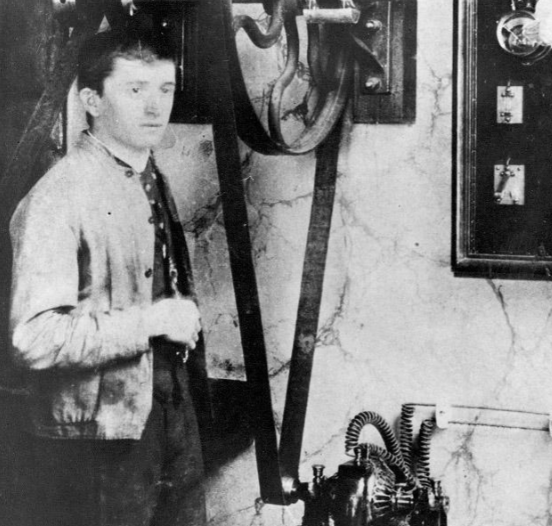
As a youngster, Ferdinand showed great aptitude for technology and was especially intrigued by electricity from a young age.
- In his mid-teens, he was already attending technical college classes while still helping his father with the family business and installed an electric lighting system in his parents’ house.
- At the age of 18 he secured his first job with the Vereinigte Elektrizitäts-AG Béla Egger, an electrical company in Vienna where he moved in 1893.
- While working in Vienna, he resumed his technical college education as a part-time student, but never completed any formal engineering education.
- During his five years with Béla Egger, he progressed from mechanic to head of the testing department and the first vehicles he designed, built and raced had electric wheel-hub-drive motors of his own design, but first developed by American inventor Wellington Adams.
- In 1897, he also began working at k. u. k. Hofwagenfabrik Jacob Lohner & Co., Vienna, in the newly established “Electric Car Department”.
- In 1900, the Lohner-Porsche – a non-transmission vehicle powered by the Porsche wheel-hub engine – was celebrated as an epoch-making innovation at the world trade fair in Paris.
- Porsche tested his designs in races with great success, winning the Semmering circuit near Vienna in 1900.
- In 1902, as a k. u. k. reserve foot soldier, he was the driver for Archduke Franz Ferdinand, using a vehicle produced from his own designs.



In 1903 at the age of 28, Porsche married Aloisia Johanna Kaes and had two children, Louise (1904) and Ferdinand Anton Ernst (“Ferry”) Porsche (1909).
In 1906, after eight years at Lohner and at the age of 31, Ferdinand Porsche took up the position of Technical Manager at Austro-Daimler in Wiener Neustadt and became General Manager in 1917 at the age of 42.
- In 1910 and at the age of 35, at the wheel of an Austro-Daimler car that he designed himself, Ferdinand won the “Prinz-Heinrich Race”, an important long-distance test for touring cars.
- In 1922, Ferdinand Porsche presented the “Sascha”, a small 4-cylinder racing car with a displacement of 1.1 litres. At first go in the same year, the “Sascha” snapped up first and second places in its particular category in the Targa Florio race in Sicily.
- Gazetta dello Sport commented on its success as follows: “Up until very recently no one would have dreamed it possible to achieve such top speeds and durability with a 4-cylinder engine belonging to the category of smallest cars ever.”
- During the course of his employment as Technical Manager, Ferdinand Porsche created numerous designs, including high-performance aircraft engines and large tractive machines, as well as fire engines, trolley buses and transport systems with hybrid petrol-electric drive.
Porsche joined Daimler-Motoren-Gesellschaft in Stuttgart as a Technical Manager and an Executive Board member in 1923 at the age of 48.
- He oversaw enhancement of the Mercedes compressor car and in 1924, he became the overall winner of the Targa Florio race in this car.
- The Institute of Technology in Stuttgart conferred the honorary title of Dr. Ing. on Ferdinand Porsche following this great achievement.
- His compressor designs for the Mercedes-Benz S, SS and SSK became synonymous for sportiness and racing success.
The Founding of Dr. Ing. h. c. F. Porsche GmbH
In 1928 at the age of 53, Porsche’s daughter Louise married Viennese attorney-at-law Dr. Anton Piëch, who in 1931 would co-found her father’s company, “Dr. Ing. h. c. F. Porsche GmbH” along with the financial backing of business man and auto racer Adolf Rosenberger.
Dr. Porsche left Daimler-Motoren-Gesellschaft in 1929 and took up the position of Technical Manager at Steyr-Werke AG in Austria. One and a half years later in 1931 at the age of 56 and with his 22-year-old son Ferry at his side, Porsche set up his own independent design office.
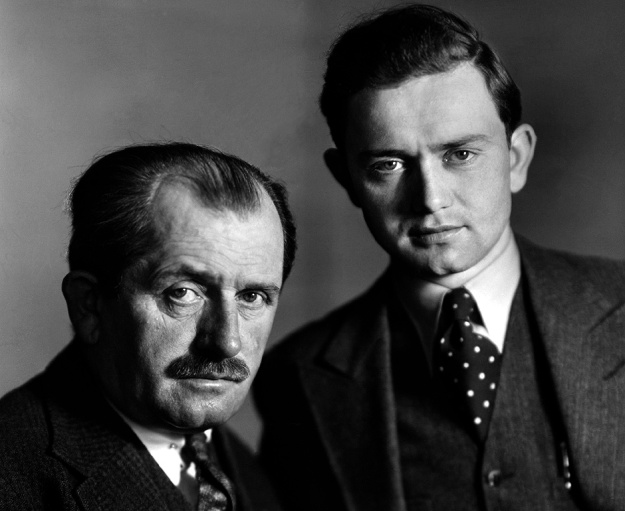
- The event was recorded in the Stuttgart Commercial Register on 25th April 1931 as “Dr. Ing. h. c. F. Porsche GmbH, Konstruktionen und Beratung für Motoren und Fahrzeuge” (design engineering and consultation for engines and vehicles).
- Porsche founded the company with Adolf Rosenberger and his son-in-law Anton Piëch in 1931. The main offices was at Kronenstraße 24 in the center of Stuttgart. Initially, the company offered motor vehicle development work and consulting, but did not build any cars under its own name.
- By 10 August 1931, Porsche registered the patent on the torsion bar suspension, which a well-known specialist journalist later commented would have sufficed to commemorate the Porsche name in the automobile world.
- In 1932, Porsche was contracted by Auto Union to design a 16-cylinder compressor Grand Prix racing car for the new 750-kg formula.
- The mid-rear engine mounted Auto Union P-Wagen with four-wheel independent suspension powered by a V-16 engine producing in the region of 300bhp made its public appearance with a flourish in 1934.
- It was designed under Porsche’s direction by engine specialist Josef Kales; Porsche’s right hand man Karl Rabe; Ferry Porsche; and Adolf Rosenberger, with financial backing from a friend of Rosenberger.
- The Auto Union P-car (P for Porsche) won 32 races out of 64, and drivers such as Hans Stuck and Bernd Rosemeyer set many world records in it.
- Ferdinand Porsche was already mulling over the idea of building a small car when he was at Austro-Daimler and Daimler-Benz, one of high quality suitable for everyday use, which was not just a smaller version of the known saloons.
- On 22 June 1934, a contract was concluded between the Porsche design office and the Reichsverband der Automobilindustrie (the umbrella organisation of the German automotive industry, which later became the Verband der Automobilindustrie (VDA)).
- With that contract, Volkswagen was born, and the founding stone was laid for the Volkswagen plant in 1938.
- In the following period, Ferdinand Porsche was one of the general managers of Volkswagenwerk GmbH.
- However, shortly before production started, the Second World War broke out and the Volkswagen “beetle” initially served as a basis for developing the all-terrain or amphibian car.
The Volkswagen Beetle & World War II
One of the first assignments the new company received was from the German government to design a car for the people; that is, a Volkswagen. This resulted in the Volkswagen Beetle, one of the most successful car designs of all time. The very streamlined Porsche 64 was developed in 1939 using many components from the Beetle with the body styled by Erwin Komenda clearly established “the pre-war Porsche look” that was carried over to the 1948 Gmund 356/1, also designed by Komenda. Only three model 64’s were built.


During World War II, Volkswagen production turned to the military version of the Volkswagen Beetle, the Kübelwagen, 52,000 produced, and the amphibious Schwimmwagen,15,584 produced.
After the war, Ferdinand and Ferry Porsche, as well as Ferdinand’s Son-in-Law and business partner Anton Piëch who were all involved in both pre-war civilian and war-time military vehicle production and the management of Volkswagenwerk GmbH, were arrested as criminals of war on 15 December 1945. Without any trial, a bail of 500,000 francs for each of the Porsches was set that could be afforded only for Ferry while his then 70-year-old father and brother-in-law Anton Piëch spent 20-months in the Dijon prison.
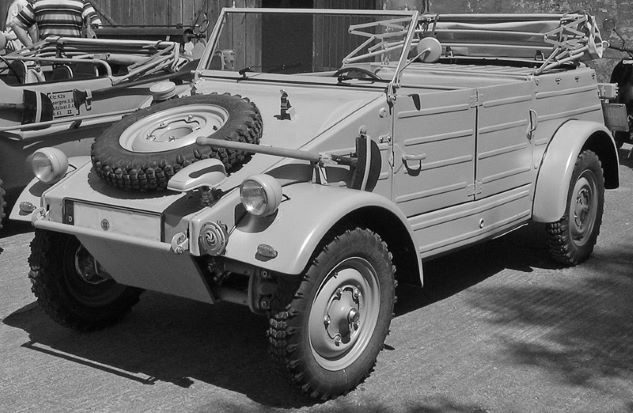

At the end of World War II in 1945, the Volkswagen factory at KdF-Stadt fell to the British. Dr. Porsche lost his position as chairman of the board of management of Volkswagen, and Ivan Hirst, a British Army major, was put in charge of the factory. (In Wolfsburg, the Volkswagen company magazine dubbed him “The British Major who saved Volkswagen”.) On 15 December of that year, Dr. Porsche was arrested for war crimes, but not tried.
Ferdinand’s son Ferry & daughter Louise Revive Dr. Ing. h. c. F. Porsche GmbH
After his release, Ferry Porsche attempted to return to Stuttgart but was barred by the occupation forces and, in July 1946, he brought all the structure of “Dr. Ing. h. c. F. Porsche GmbH” to Gmünd/Carinthia, Austria. Together, with his sister Louise, Ferry took over the management of the company and early on, the workshop was primarily used for automotive repair.
They eventually obtained two contracts for automobile design. One was for the construction of the model 360 race cars for the Cisitalia racing team. The other was for the design of their own car, which later became known as the Porsche 356. The 356 came about as during his father’s 20-month imprisonment, Ferry decided to build his own car, because he could not find an existing one that he wanted to buy. He also had to steer the company through some of its most difficult days until his father’s release in August 1947. It was Ferry’s designs and flair for business that turned the Porsche design and engineering company into a world-famous sports car producer.
By 1947, Ferry had gathered the stipulated bail needed using early fees for his new designs, and father was then released on 1 August 1947, along with Anton Piëch.
During his 20 months of jail time in Dijon, Ferdinand collaborated on designs for Renault and their later popular 4CV and it is speculated that the conditions of his imprisonment contributed to his health decline, and later, his death. After being released and once in Austria, the senior F. Porsche reviewed the designs of his son for both projects; the 360 Cisitalia and the 356. He consented with the plans and aided the projects which were in progress. He commented daily to their employees that he “would have done the same designs as Ferry”. However, for the rest of his life the senior Porsche was in ill-health and in November 1950, Ferdinand Sr. suffered a stroke which disabled him until his death, on 30 January 1951, aged 75.
Like his father, Ferry Porsche never completed a formal college or university-level education program, taking courses early-on that helped him as needed following the role-model of his father. And, like his father, later-on in life he was awarded an Honorary doctorate from Vienna Technical College and one from the University of Stuttgart in 1965, and an Honorary professorship from the federal state of Baden-Württemberg in 1984. His son F.A. “Butzi” Porsche, likewise went into the family business where he honed his skills vs. completing a formal, university level education. However, his brother Wolfgang broke the mold and obtained a business degree, began a business importing Yamaha motorcycles before entering the automotive industry via Daimler-Benz and then moving on to assume the leadership role at Porsche.
After her father’s death, Louise assumed management of Porsche Konstruktionen GmbH, the predecessor of Porsche Holding in Austria. Louise and Anton Piech’s son, Ferdinand, unlike Louise, Ferry or Bitzi, studied at the Lyceum Alpinum Zuoz and graduated from the ETH Zurich, Switzerland, in 1962, with a degree in mechanical engineering, having written a master thesis about the development of a Formula One engine. At the same time, Porsche was involved in F1 and developed an 8-cylinder engine for the Porsche 804. From 1963 to 1971, he started his career at Porsche in Stuttgart, on the development of the Porsche 906 and following models that led to the successful Porsche 917. In 1972, he moved to Audi in Ingolstadt after an agreement was forged by Ferry Porsche after finding he was unable to bring unity to the divided Porsche – Piech families and decreed that no member of the Porsche or Piëch families should be involved in the day-to-day operations of the Porsche company.
Ferdinand Piëch eventually became the head of Audi, where he is credited with evolving and growing Audi into a competitor to equal Mercedes-Benz and BMW, thanks in part to innovative designs such as the Quattro and 100. In 1993, Ferdinand became the chairman and CEO of Volkswagen Group, which he is credited with turning into the large conglomerate it is today; He oversaw the purchase of Lamborghini and Bentley, as well as the founding of Bugatti Automobiles, all of which he integrated with the Volkswagen, Škoda, SEAT and Audi brands into a ladder-type structure similar to that used by Alfred Sloan at General Motors. Ferdinand was required to retire at age 65 per Volkswagen company policy, but he remained on its supervisory board and was involved in the company’s strategic decisions until his resignation on 25 April 2015.
Ferdinand Piëch undeniably influenced the development of numerous significant cars including the Porsche 911, Audi Quattro and notably, the Bugatti Veyron, which as of 2012 was the fastest, most powerful and most expensive road legal automobile ever built. Due to his influence on the automobile industry, Ferdinand was inducted into the Automotive Hall of Fame in 2014.
Interesting Additional Reading on the Porsche Legacy:
- Randy Leffingwell’s, Porsche 911 – 50 Years
- Porsche-Piëch Family @ Wikipedia
- Ferdinand Porsche Bio @ StuttCars.com
- Anton Piëch @ Wikiwand
- Adolf Rosenberger, the Forced-Out 3rd Founder, @ Forbes
- Ferdinand Anton Ernst “Ferry” Porsche Bio @ StuttCars.com
- Before passing away, Ferdinand Piëch exhorted his heirs to keep the Porsche-Volkswagen Group intact
- Stuttgart DNA, Ferry Porsche biography
- Ferdinand Karl “Burli” Piëch
- F.A. “Butzi” Porsche Bio @ Stuttcars.com
- Wolfgang Porsche @ Porsche.com
Porsche North America & Max Hoffman
Sources for this article included: Love of Porsche – von Neumann, Automobile Hall of Fame – Hoffman, MotorTrend – Hoffman, MotorTrend – Circle of Legends, ClassicTrader – Hoffman, PCA – 70th Anniv, Drive-My – Hoffman, Driven-to-America – Hoffman and others.
The Reader’s Digest Version:
From Autoliterate and many other sources identified in the “Wall Street Journal Version” located below the auto galleries and their specific details.
The Hoffman Motor Car Company: Born in Austria in 1904, Maximillian Edwin Hoffmann was a pioneer in the automobile import and distribution industry, being the first in North America to import marques such as Alfa Romeo, BMW, Jaguar, Mercedes-Benz, Porsche and Volkswagen.
As background, in the late 1930s Hoffmann moved his existing import auto sales business from Austria to Paris, then he immigrated to New York with the intention of re-establishing his auto import business in the U.S.. However, he arrived on U.S. soil the the same day the U.S. was thrust into World War II. Unable to resume importing and selling cars with the world at war, he began a costume jewelry business manufacturing metallized plastic with $300 and was successful enough to afford him re-entry to the auto industry.
He formed the Hoffman Motor Car Company in 1947, establishing dealerships in New York City and Beverly HIlls, CA, noting he dropped the second ‘n’ from his last name in an effort to make it sound more American. As legend has it, his showroom opened with a single extremely expensive French Figoni et Falaschi-bodied Delahaye four passenger Coupé and by 1949, he was the importer for Jaguar, Rolls-Royce, Bentley, Austin-Healey, Cooper, Rover, Lea Francis, Morgan and Volkswagen, adding Mercedes and Porsche in 1952. On the West Coast, with his second Hoffman Motor Car Company located in Beverly Hills, by 1948 he became the largest Jaguar dealer on Americas West Coast, with eventually more than 475 sub-distributors and dealers located in over 370 cities and towns throughout the United States.
Max Hoffman married his wife Marion in 1955 and they spent their married life living in New York, Palm Beach and Beverly Hills. During the 1960s, Hoffman sold off his import businesses and concentrated on BMW exclusively until eventually selling the last piece of his business to them, which became BMW North America in 1975. Max passed in 1981 at the age of 77, and in 1982 his now widow Marion established the Maximilian E. and Marion O. Hoffman Foundation Inc., endowed with their considerable wealth noting she passed in December 1983 after a battle with cancer. The foundation continues to make generous annual donations totaling $2.7-million in 2020, with assets of $52.2-million.
From Porsche.com: 60 Years of Porsche in America
The Porsche Era Begins: In 1950, a decisive meeting took place at the Paris Motor Show between Dr. Ferdinand Porsche and Max Hoffman. Now a U.S.-based importer of several different European automobile brands on the American East Coast, Hoffman had his own dealership network, as well as an unerring sense of what wealthy Americans were looking for when it came to automobiles.
In early conversations, Ferry Porsche said he would be happy to sell five cars a year in America, to which Hoffman famously replied: “If I can’t sell five a week, I’m not interested.” Eventually, they agreed on a U.S. import contract of 15 cars per year. Ferry Porsche and Hoffman concluded a deal soon afterwards for the delivery of 153 Porsches annually, the first three vehicles of which were shipped to the USA as early as October 1950.
Note 3: by 1954, Hoffman’s network was selling 11 cars per week, equaling 30 percent of the annual Porsche production. The Porsche of America Corporation was founded in 1956, taking over national representation of the brand from Max Hoffman.
When the first Porsche 356’s arrived in the USA, Max Hoffman once again proved just how much marketing talent he had. In parallel with the presentation at his modern showroom on New York’s Park Avenue, he also handed over a Porsche 356 to the private racing driver Briggs Cunningham, who soon began delivering the first victories on the race track.
The Porsche 356 rapidly became the insider tip in the American racing scene, which had a positive effect on more than the sales figures. The German sports car, that was fast but also suitable for daily use, also became a hit in Hollywood, and was a favorite among film stars, James Dean in particular. The combination of racing sports and Hollywood glamour helped the Porsche brand name to achieve its unique lifestyle image in America, something which also reflected back to Europe again.
Beyond that, Max Hoffman had recognized there was a need for country-specific models if victory was going to be won in the long term on the hard-fought American market. Hoffman accordingly pressed for a particularly light and economical version, which from 1954 arrived on the market in the form of the 356 Speedster, based on the small series 356 America Roadster which had made its debut in 1952. With a basic price tag of 3,000 US Dollars, the Speedster, with its spartan fittings, became a great sales success in sunny California in particular.
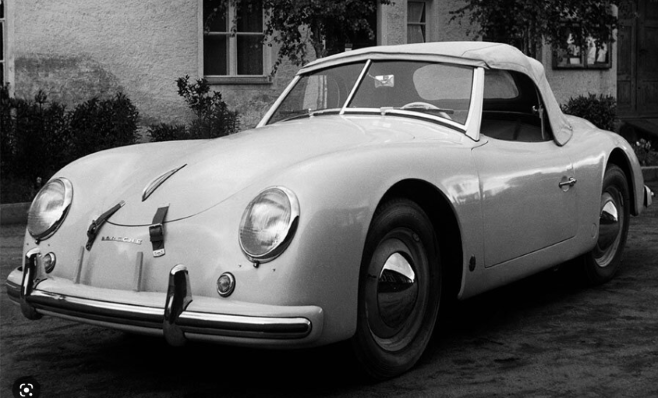
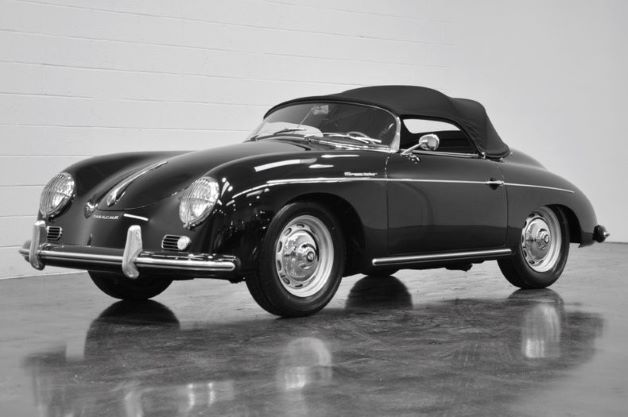
The success on the US market had an extraordinarily positive effect on Porsche KG sales. As early as the first few years of the co-operation, there were considerably more sports cars exported to the USA than the company’s president, Ferry Porsche had expected.
- In 1952 this amounted to 283 Porsche vehicles, meaning that some 21 percent of total sales had gone to America.
- This proportion increased steadily in the years which followed, with the 50 percent mark being exceeded for the first time in 1955 (from a total production of 3,624 vehicles). And in succeeding years this figure was surpassed again and again.
- In 1965, the last production year of the Porsche 356, the share of sales to the US amounted to a huge 74.6 percent.
- To this day, the United States market is still the most important sales outlet for Porsche.
- Headquarters for Porsche Cars North America is Atlanta, and in total there are more than 200 Porsche dealers in the USA.”
Hoffman was so successful with just his Jaguar enterprise that, in 1954, he commissioned Frank Lloyd Wright to design the Hoffman Auto Showroom for his dealership at 430 Park Avenue in New York City in 1954 which ended-up being used mostly for his newer brands, Mercedes and Porsche. Noting that Wright was a auto enthusiast who owned over 80 cars during his life, as part of his commission, Wright received a pair of Mercedes, one of which was a 1955 Mercedes 300SL Gullwing. Hoffman subsequently had Wright design a 5,100-sq-ft single-story L-shaped home and Japanese garden on 2-acres of land on the shore of North Manursing Island overlooking Long Island Sound for he and his wife Marion whom he married in1955: they lived in the home until 1972.



Porsche’s 60 most entertaining facts and milestones
Source: MotorTrend
1. The 1898 Lohner-Porsche Elektromobil was the first car in the world with brakes on all four wheels.
2. Professor Ferdinand Porsche chauffeured Austrian Archduke Franz Ferdinand in a Lohner-Porsche in 1902.
3. During WWI, Ferdinand Porsche designed heavy transport vehicles, flatbed trailers with the wheels powered by individual hub-motors.
4. Beutler Carrosserie turned closed 356s into open ones, completing its first custom Cabriolet in 1947, three years before Porsche came to America and a full seven years before the 356 Speedster (a “stripped” and cheaper 356) was introduced.
5. U.S. importer Max Hoffman displayed the first U.S. Porsches in his New York City showroom by late 1950.
6. In 1952, U.S. automaker Studebaker contracted Porsche to develop a new car and engine (it was never produced).
7. Hoffman conducted Porsche 356 test drives on Park Avenue, an accomplishment that could not be proficiently duplicated today.
8. Hoffman’s Porsche dealer showroom was designed by architect Frank Lloyd Wright. It is now a modern office building with a Mercedes-Benz dealer on the street level. Hoffman also contracted Wright to build his home in Rye, New York.
9. In addition to importing the first Porsche models to the United States, Max Hoffman also raced Porsches. Several of Porsche’s initial U.S. racing victories can be attributed to him.
10. Hoffman is also credited for the birth of the Porsche Speedster, with the intention of producing a lower-cost Porsche to compete with the Austin Healey 100, Triumph TR-2, and MG models in the United States.
11. In 1952, Hollywood dealer John von Neumann wanted to race a Porsche, so he ordered a 356 without paint or upholstery to modify it himself.
12. The Porsche logo/crest was designed in 1952 on Dr. Ferry Porsche’s napkin as he sat opposite U.S. importer Max Hoffman in a New York restaurant. (The actual history can be found at the Porsche Coat of Arms, above.)
13. In the original 356 Speedster, a tachometer was not standard, nor were padded seats, sunvisors, or heaters.
14. An exhibit at the Museum of Modern Art in 1953 featured 10 automobiles, including a 1952 Porsche 1500 Super.
15. The first Porsche appeared at the New York auto show in 1954. It was called “a snappy Porsche roadster.”
16. The Porsche Club of America was founded in 1955, only five years after Porsche was introduced to the United States.
17. The word “Continental” appeared on the side of the 1955 Porsche Coupé and Cabriolet, but only in North America.
18. The Porsche of America Corporation was founded in 1956, taking over national representation of the brand from Max Hoffman.
19. The inaugural Porsche Parade took place in greater Washington, D.C., on August 29, 1956.
20. The first appearance of a Porsche at the historic 12 Hours of Sebring endurance race was in 1953.
21. One of the first U.S. Porsche brochures in the 1950s featured a pair of woman’s gloves on the cover with a set of Porsche keys. The tagline read: “The keys to miles of pleasure …”
22. British automotive weekly publication Autocar became the first outlet to test a Porsche in April 1956, driving a Porsche 356.
23. The first Porsche series-produced roadster was aptly named the America Roadster for its distribution entirely within the United States. It was completely unpublicized in Europe and only 16 models were ever built.
24. The first vertical-drive German inline engine was displayed at the 1958 New York auto show along with several other “firsts,” including the first diesel outboard motor.
25. Frenchman Jean Behra drove the first single-seat Porsche race car in the 1958 Formula 2 race at Rheims, France. He took first place, beating out notables Bruce McLaren, Graham Hill, Sir Stirling Moss, and Jack Brabham.
26. The “D” in the 1959 Speedster D takes its name from the Drauz Factory of Heibronn.
27. The 1950s Porsche airplane engine (based on the 356’s 1.6-liter) could power a helicopter when mounted vertically.
28. Rear seats, auxiliary driving lights, and bumper overriders were the prime accessories fitted to new Porsches in 1960. The starting price for one of these new models was $3,400.
29. Porsche took its first overall win at the 12 Hours of Sebring endurance race in 1960.
30. Porsche’s production of diesel tractors peaked in 1960-’61 with 150,000 units.
31. Dan Gurney won Porsche’s first world championship Grand Prix victory at Rouen, France, in 1962.
32. The 911 was originally the 901, until Peugeot informed Porsche of its trademark rights on cars named with a zero between two numbers.
33. At the end of its production in 1965, Porsche 356 models were being produced exclusively for the American market.
34. 1966 was the first full production year for the 900 series Porsches and half were shipped to the United States, while a quarter stayed in West Germany.
35. The 907 prototype racer, developed in winter 1966-’67, was the first Porsche to go faster than 186 mph (300 kph).
36. In 1967, a Targa version of the popular-selling 911 model was introduced. It included a stainless-steel rollbar to address suspicions that the United States would outlaw open-top convertibles.
37. Porsche’s 914/4 model was sold as the VW-Porsche in Europe, and only wore the Porsche crest in the United States.
38. Only two 914/8 models were created. Each was powered by a 300-horsepower eight-cylinder boxer engine derived from racing. One was given to Ferry as a birthday gift for his 60th birthday.
39. More than 100 dealerships marked the increasing popularity of Porsche models in the United States by opening simultaneously on November 1, 1969.
40. The 1970 Porsche 914 was initially ruled as unsafe for driving in the United States because it lacked proper side marker lights on its front end.
41. The first ever Porsche “driver’s school,” a precursor to the current Porsche Sport Driving School, was conducted on May 29, 1971, at Mitchell Field, Long Island, New York.
42. The 1975 Silver Anniversary limited edition was built in Coupé and Targa body forms, painted diamond-silver metallic, and individually numbered starting with 2.
43. The 1976 912E used Bosch L-Jetronic fuel injection, hence the “E” which stands for Einspritzung, or “injection.”
44. The 924/944 water-cooled Porsche models were designed by an American, Tony Lapine.
45. The first few Porsche 924 Turbos to come to the United States had black and white-checkered flag fabric on the seat inserts and door panels.
46. Porsche partnered briefly with Indianapolis 500 racing in 1980 for the first time in its long motorsports history on the Formula One racing circuit.
47. The Interscope Porsche, developed for racing in the Indianapolis 500 race in 1980, was originally unveiled at a press conference at Tavern on the Green restaurant in New York City.
48. The enduring success of the 911 model is owed to American CEO Peter Schutz, who in 1980, after seeing the proposed end of production in 1981 on a chart, extended the line with a marker and told Helmuth Bott to “make it happen.”
49. It is largely believed that Peter Schutz was selected as CEO of Porsche from 1981 to 1986 because, as an American, it was hoped that he would revive dwindling U.S. 911 sales.
50. The success at the 24 Hours of LeMans in 1981 was credited to combining chassis from three 936 models with experimental engines developed for U.S. Indy Car racing.
51. Porsche began promoting vacation delivery in 1982: Order the car in the United States, take delivery in Europe, drive around the Continent and return the car to the factory to have it shipped home.
52. The Porsche 928 in the film “Risky Business” is actually four cars ranging from 1979 to 1981. Each car had different options such as interior colors, wheel designs, and even paint colors. The production crew had to be very careful about which part of the cars they filmed to make it look like only one vehicle was used in the movie.
53. Al Holbert set a FIA international class speed record while driving a stock 928 S4 at the Bonneville Salt Flats on August 7, 1986. His speed: 171.110 mph.
54. Porsche 911 engines were air-cooled for 34 years before switching to a water-cooled format in 1998 to meet increasingly stringent environmental rules and Porsche’s desire to provide more power while reducing fuel consumption.
55. In 1992, it took 125 hours to build a Porsche 911. By 1994, the factory was down to 80 hours, thus reducing the cost of the cars.
56. The Porsche 911 RS entered the United States in 1993. The “RS” stands for “Rennsport,” German for “race sport” or racing. It had no sunroof, A/C, back seat or power steering.
57. Porsche was the first auto manufacturer to make passenger air bags available, optional or standard.
58. The names for both the 911 Carrera and the new Panamera Gran Turismo came from Mexico’s historic Carrera Panamericana race, where Porsche scored many victories.
59. Notable past and current American celebrities who are or were Porsche enthusiasts include James Dean, Paul Newman, Steve McQueen, Ralph Lauren, Jerry Seinfeld, Jay Leno, and Patrick Dempsey.
60. The correct pronunciation of Porsche is “Por’-shuh.”
A Passion for Porsche, the 13th in the Savoy’s Lecture Series, 30 June 2023
Miss Debbie joined me on the evening of 30 June 2023 for the latest in the Savoy Automobile Museum’s ‘Lecture Series.” A Passion for Porsche was associated with the 75 Years of Porsche exhibit and featured the principles of two Porsche collections with the two of the most significant vehicles in the collection. The lecture was preceded by a wonderful reception with heavy hors d’oeuvres in the Savoy’s cafe where we had a delightful time visiting with several of friends we’ve met through the Savoy. These are exceptional events.

